Reserve Bank of Australia Annual Report – 2021Communication and Community Engagement
The Reserve Bank is committed to its communication being open, transparent and accountable. The Bank's staff across Australia work to understand community priorities and concerns and, in turn, explain the Bank's policies and decisions. The Bank engages with the community in a range of ways, including via a longstanding regional and industry liaison program and a public education program. It consults with businesses, consumer groups and payments industry participants on issues in payments policy. The Bank communicates its policy decisions, and the context in which these are made, through speeches and publications. The Bank participates in parliamentary hearings and responds to public enquiries. It supports academic research, publishes a broad range of statistics and operates a museum where visitors can discover the history of Australia's banknotes and economic development.
Publications and speeches
The Reserve Bank's communication about its policy decisions, analysis and operations is primarily through publications and speeches. Announcements about monetary policy decisions are made shortly after each Reserve Bank Board meeting and minutes are released two weeks later. A media release is published following each Payments System Board meeting, outlining issues discussed at the meeting and foreshadowing any forthcoming documents to be released by the Bank.
Public appearances provide an opportunity to communicate the Reserve Bank's analysis of economic and financial developments and how they have influenced monetary policy decisions, as well as to respond to questions in a public forum. Following the November 2020 Reserve Bank Board meeting, the Governor addressed and took questions from the media and financial market participants to explain a package of further significant measures to support the Australian economy in its recovery from the COVID-19 pandemic. These measures included the introduction of the government bond purchase program and a reduction in key policy interest rates (see chapter on ‘Operations in Financial Markets’). A media and markets briefing was also provided in July 2021, when the Reserve Bank Board decided to continue purchasing government bonds after the completion of the previous purchase program in early September 2021 at a reduced rate of $4 billion of bonds a week and to retain the April 2024 bond as the bond for the yield target. As is the case for all of the Governor and Deputy Governor's speeches, audio of each address was broadcast live, including the question and answer sessions with participants, and transcripts were published to the Bank's website. For the July 2021 briefing, a video of the event was also published.
During 2020/21, the Governor, Deputy Governor and other senior staff gave 32 other public speeches on various topics. Given the pandemic, 25 of these were delivered ‘virtually’. Senior staff also participated in public panel discussions and parliamentary hearings. The pandemic limited the opportunity for public appearances to be scheduled in regional centres in 2020/21; nevertheless, the Governor was able to address the Australian Farm Institute Conference in Toowoomba in June 2021. There were speeches on the changing economic outlook and innovation and regulation in the Australian payments system, as well as speeches by senior staff on changes in payments, digital transformation and the impact of the virus on the economy and financial system. These speeches, the associated question and answer sessions and the panel discussions were published on the Bank's website in audio, text and, in July 2021, video formats to facilitate transparency and accessibility.
The Reserve Bank also explains its analysis through a number of regular publications:
- the quarterly Statement on Monetary Policy provides information about the Reserve Bank's assessment of current economic and financial conditions, along with the outlook for economic activity and inflation in Australia
- the Financial Stability Review, published semi-annually, provides a detailed assessment of the condition of Australia's financial system and potential risks to financial stability
- the quarterly Bulletin contains analysis of a broad range of economic and financial issues, as well as aspects of the Bank's operations; during 2020/21, 44 articles were published in the Bulletin.
The Reserve Bank publishes information in both electronic and hard-copy formats, with most people accessing the information online. Followers of the Bank's social media accounts on Twitter, LinkedIn, Facebook and Instagram have grown to over 158,000, while the number of subscribers to the conventional email alert service is around 12,400. Visitors to the Bank's website also made use of the RSS feeds, which provide alerts about data updates, media releases, speeches, research papers and other publications, including those related to Freedom of Information requests.
The Reserve Bank's website has continued to evolve with new and refreshed content. In 2020/21, the Bank continued to provide digital material to support students and teachers of economics. It also facilitated greater access to archival material with new online exhibitions on the Museum website and the launch of the Unreserved platform. More information on these activities is provided below. The Bank also introduced the Financial Stability Review ‘At a Glance’ and launched a podcast in May to aid accessibility of content for a broader audience. The Banknotes microsite is used to communicate information about the new banknote series issued by the Bank. This microsite has continued to evolve with the final denomination in the series – the new $100 banknote – entering general circulation in 2020/21.
Regional and industry liaison
Staff in the Reserve Bank's regional and industry liaison team – which operates from four State Offices around Australia (Adelaide, Brisbane, Melbourne and Perth) and the Bank's Head Office in Sydney – work together to conduct the Bank's liaison program. Staff in the liaison program meet regularly with businesses from all sectors of the economy, associations, governments and community organisations from across the country, including in regional areas. In 2020/21, just over 900 liaison meetings were conducted. While liaison staff have been limited in their ability to visit contacts over the past year, engagement has continued via telephone and videoconference meetings.
Timely information provided by liaison contacts helps the Bank to monitor trends in the Australian economy and assess the effect of unusual events, such as the COVID-19 pandemic. This information complements data from official sources, allowing the Bank to better understand the issues affecting businesses and the economy in general. The timeliness of information gathered from the Bank's liaison program has been particularly valuable during the COVID-19 pandemic, enabling the Bank to quickly assess the impact of containment measures and other disruptions to the Australian economy prior to it being captured in official data sources. The liaison program has also provided valuable information about the impact of the pandemic on businesses and households and their responses, the pace and nature of the economic recovery, and the effectiveness of monetary and fiscal support measures. Summary messages from liaison about the impact of the pandemic are regularly shared with the Reserve Bank Board, senior management and other government agencies.
Broad messages from liaison inform the Reserve Bank Board's policy decision-making and are communicated to the public through the Bank's regular statements and reports, as well as speeches by senior staff. Liaison information is also regularly drawn upon in the Reserve Bank Bulletin and the Statement on Monetary Policy; in 2020/21, topics covered included supply chain disruptions during COVID-19, the east coast gas market and the impact of the pandemic on Australia's education and tourism exports.
Following the introduction of COVID-19 containment measures in March 2020, all liaisons meetings were conducted via telephone or videoconference for the remainder of 2020. This shift allowed the liaison team to conduct a significantly higher-than-usual number of meetings during the early phase of the pandemic and into the second half of 2020. With economic conditions evolving rapidly, more frequent meetings with liaison contacts ensured that the Reserve Bank Board was kept informed of developments. Since early 2021, most offices transitioned towards a mix of in-person and virtual liaison meetings where circumstances permitted.
Staff from the State Offices have an important role in the Bank's communication with members of the public, as they are well positioned to hold discussions with a broad cross-section of the community. In 2020/21, State Office staff gave around 10 presentations to members of the community, including at schools, business roundtables and regional chambers of commerce. In addition, Bank employees presented summaries of the Statement on Monetary Policy and the Financial Stability Review during the year to around 250 participants in the liaison program. These presentations were all conducted virtually, enabling contacts from both city and regional areas to attend.
As noted in the chapter on ‘Governance and Accountability’, the Reserve Bank Board would usually meet in state capitals other than Sydney on a regular basis, and a dinner would be held with members of the local community, including representatives and leaders from politics, business, the public sector, and educational and community organisations. However, in 2020/21 no community dinners were held owing to the containment measures and domestic travel restrictions associated with COVID-19.
The Reserve Bank also convened its annual Small Business Finance Advisory Panel in July 2021 in virtual form given the public health situation. The Panel, which was established in 1993, discusses issues relating to the provision of finance and the broader economic environment for small businesses. Membership of the panel is drawn from a range of industries across the country. The Panel provides a valuable source of information on financial and economic conditions faced by small businesses. An article drawing on the Panel's discussions in 2020 and other sources of information on small business finance appeared in the September 2020 Bulletin,[1] and the latest panel discussion and sources of information is covered in the September 2021 Bulletin.[2]
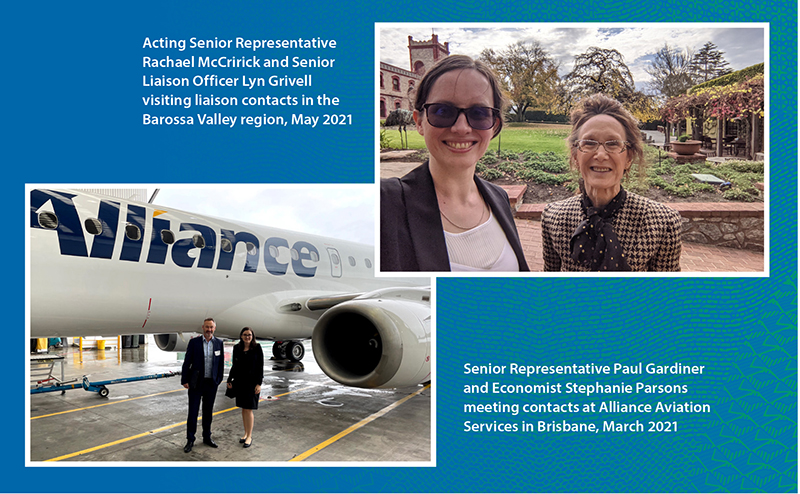
Consultations and public enquiries
The Reserve Bank maintains engagement with a wide variety of groups to inform its policy and operational activities. Senior Bank staff meet regularly with representatives of various domestic and international official agencies, business groups and financial market participants to discuss economic, financial and industry developments.
In May, the Bank published a consultation paper on the preliminary conclusions of the Payments System Board on the comprehensive Review of Retail Payments Regulation, which began in late 2019. The paper also sought stakeholder views on draft regulatory standards that would implement the preliminary conclusions of the Review. The Review is expected to be completed in the coming months.
In June 2021, the Council of Financial Regulators (CFR) – comprised of the Reserve Bank, the Australian Prudential Regulation Authority (APRA), the Australian Securities and Investments Commission and the Australian Treasury – published its advice to the Australian Government to enhance the regulation of financial market infrastructures, including crisis management powers over clearing and settlement facilities. In proposing these reforms, the CFR took into account the responses it received to a consultation commenced in 2019. In May 2021, the government announced that it will introduce the reforms recommended by the CFR.
The Reserve Bank held two meetings of its Payments Consultation Group in 2020/21. The Group, which was established in 2014, is a structured mechanism for representatives of various users of the payments system (consumers, merchants, other businesses and government agencies) to convey their views on payments system issues as an input to the payments policy formulation process. More details on the activities of this group are provided in the Payments System Board Annual Report 2021.
Staff from Payments Settlements Department continued to conduct regular liaison meetings with Reserve Bank Information and Transfer System (RITS) members and industry groups, such as the Australian Payments Network (AusPayNet). Staff also participated in various industry forums, including AusPayNet's High Value Clearing System Management Committee. A senior staff member sits on the board of AusPayNet and another senior staff member sits on the board of New Payments Platform Australia Limited (NPPA), the company established to build and operate the NPP. Staff from Payments Settlements and Banking departments represent the Bank on NPP operating committees. Participation in these groups, and a number of other industry forums, helps the Bank to remain well informed about developments in these areas and contribute to innovations in the banking and payments industry.
The Reserve Bank sponsors and provides the secretariat to the Australian Foreign Exchange Committee (AFXC). The AFXC is a member committee of the Global Foreign Exchange Committee (GFXC), of which the Deputy Governor is the Chair. During 2020/21, the AFXC contributed to the GFXC's review of the FX Global Code (see chapter on ‘International Financial Cooperation’).
During the year, the Bank received approximately 2,800 public enquiries on a broad range of topics, including monetary policy, the economy, financial markets and regulation of the payments system. Responses were provided to the majority of enquiries received by the Bank. Staff from Note Issue Department also continued their engagement with industry and members of the public in relation to the new banknote series (see chapter on ‘Banknotes’).
Research
The Reserve Bank publishes the results of longer-term research conducted by staff in the form of Research Discussion Papers (RDPs), to stimulate discussion and comment on policy-relevant issues. The views expressed in RDPs are those of the authors and do not necessarily represent those of the Bank. During 2020/21, 12 RDPs were published on a range of topics in the Bank's areas of interest, including Australian household debt, the JobKeeper payment scheme, economic activity in Australia and central bank communication. Reserve Bank staff also published their research in various external journals, including Economic Modelling and the Journal of Banking and Finance.
Research undertaken at the Reserve Bank is frequently presented at external conferences and seminars. In 2020/21, Bank staff presented virtually at a number of conferences and institutions in Australia and overseas, including the Bank of England, the Royal Economic Society Annual Conference, APRA, the Australian Bureau of Statistics and the University of Queensland Business School.
The Reserve Bank hosts regular conferences, which foster interaction between academics, central bankers and other economic practitioners on topical policy issues. The Bank's annual conference for 2021 was again cancelled because of the pandemic. The next annual conference will be scheduled for the first half of 2022. The annual Macroeconomic Workshop was also cancelled in 2020 because of the pandemic and the 2021 Workshop remains under review.
The Reserve Bank usually hosts visits from policymakers and academics from domestic and overseas institutions. In 2020/21, the Bank facilitated such interactions through online seminars. These included presentations from the Bank for International Settlements and the Australian Treasury, as well as academics from a range of institutions including the University of Colorado, the University of California, Berkeley and the University of Melbourne.
The Bank sponsors economic research in areas that are closely aligned with its primary responsibilities. This sponsorship includes financial support for conferences, workshops, data gathering, journals and special research projects, and encompasses areas of study such as macroeconomics, econometrics and finance.
In 2020/21, the Reserve Bank continued its longstanding contribution towards the cost of a monthly survey of inflation expectations undertaken by the Melbourne Institute of Applied Economic and Social Research at the University of Melbourne. The Bank also maintained its contribution to a quarterly survey of union inflation and wage expectations undertaken by the Australian Council of Trade Unions.
The Bank continued to contribute to funding the International Journal of Central Banking, whose primary objectives are to disseminate first-class, policy-relevant and applied research on central banking and to promote communication among researchers both inside and outside central banks. The Bank also provides financial support to the Group of Thirty's program of research into issues of importance to global financial markets.
The Bank provides financial support for research on population ageing being conducted by the Australian Research Council Centre of Excellence in Population Ageing Research (CEPAR), based at the University of New South Wales. This financial support has been continued for a further three years. A senior official of the Bank sits on the Advisory Board of CEPAR.
The Reserve Bank makes a financial contribution to a number of conferences in economics and closely related fields. In 2020/21, these conferences included the Economic Society of Australia's Women in Economics Network Retreat, the University of New South Wales' Australasian Finance and Banking Conference, and the Economic Society of Australia's Australian Conference of Economists. The Bank continues its sponsorship of the Economic Society of Australia's Central Council for the second year. The three-year sponsorship helps to build and strengthen the profession and the debate on economic issues.
In addition, the Bank is a corporate member of number of economic policy institutes. In 2020/21, the Bank undertook a review of its criteria for corporate membership of policy institutes in view of the increased number of these entities in Australia and more frequent requests for sponsorship. The criteria are that the entity is: independent and not aligned with a political party or some other institution; is not for profit; regularly produces research reports and makes those research reports publicly available; covers a broad range of economic and financial issues that are relevant to the Bank's mandate (rather than specific issues); offers corporate membership that is assessed to provide good value for money; and promotes the public interest. Following this review, the Bank renewed its membership of the Centre for Independent Studies, the Committee for Economic Development of Australia (CEDA), the Ethics Alliance and the Lowy Institute for International Policy, and became a member of the McKell Institute. The Bank is also an associate member of the South East Asian Central Banks Research and Training Centre.
In conjunction with APRA, the Reserve Bank has continued to sponsor the Brian Gray Scholarship Program, initiated in 2002 in memory of a former senior staff member of the Reserve Bank and APRA. Two scholarships were awarded under this program in 2021. The cost to the Bank of this scholarship was $15,000.
The total value of support provided for research and education in 2020/21 was $297,997.
Education
Supporting educators and students is a key part of the Reserve Bank's community engagement. A dedicated team coordinates the efforts of staff across the Bank to deliver a public education program. The main focus of the program is economics education at senior high school, although educational activities are also undertaken for different stages of learning (at both school and university). In response to COVID-19, additional resources were developed to cater for remote learning needs and to explain the Bank's role in supporting the economy during the pandemic.
The Reserve Bank's commitment to economics education is motivated by the importance of economic literacy in the community and its concerns about the falling size and diversity of the economics student population. Nationally, the number of high school students studying economics in Year 12 has fallen by around 70 per cent since the early 1990s. Over the same period, the share of high schools offering economics has also fallen (particularly among comprehensive government schools), as has participation by females and students from schools that are culturally diverse or located in lower-income areas. A similar pattern is evident at university. To help address these issues, the Bank has been providing practical support by creating widely accessible resources that are aligned with curricula, giving presentations to students and offering professional development opportunities to educators. It has also been conducting research to identify where and how its efforts can be directed to support greater engagement with economics and diversity among its student body.
With the pandemic significantly disrupting in-person classes, over the past year the Bank's public education team developed a series of 29 videos that could be played to students in online classes (or by students for self-directed learning). The series included 25 short videos in which a Bank economist explained a broad range of economic concepts, with these videos ‘bringing to life’ the content of the Bank's library of written Explainers (which was further expanded). In addition, four videos were produced that summarised economic conditions at quarterly intervals, tracing the economic impact of the pandemic during the year. While the video series was designed to support remote learning by high school students, those videos on current economic conditions and the Bank's monetary policy response to the pandemic were also useful for university students and other audiences. Furthermore, the videos were valued by educators when in-person classes subsequently resumed and are considered an important new resource.
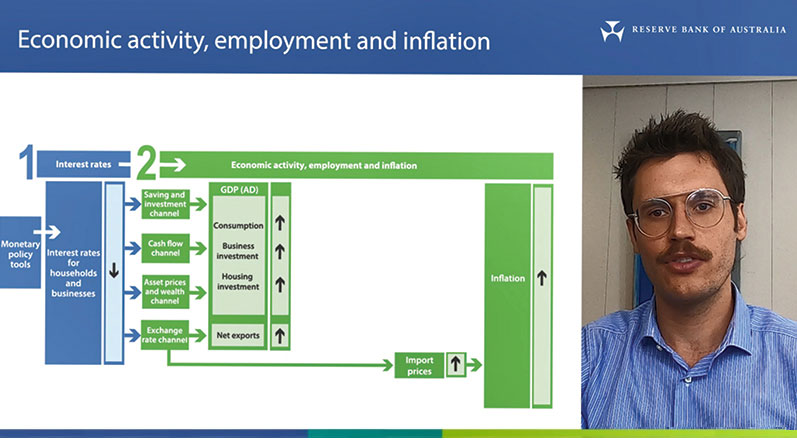
For much of the year, COVID-19 restrictions resulted in the suspension of a key aspect of the public education program - the in-person talks to students that had previously been delivered by the Reserve Bank's Ambassadors (the 50 or so Bank staff who are trained to engage directly with students). Consequently, webinars were introduced as a substitute for in-person talks for schools and student conferences. Webinars also provided the opportunity to introduce a new service for students - a review of economic conditions, accessible to all Year 12 students that preceded the commencement of their final year exams. A similar service was provided to university students. Importantly, the webinars facilitated far more participation by students from non-metropolitan areas than in previous years.

The shift to webinars extended to teacher professional development events. During the year, the Bank hosted three online professional development events for economics teachers and participated in two others, one of which was in-person. The focus of these events was an explanation of the economic effects of the pandemic and the Bank's monetary policy response, which entailed a revised approach to the implementation of monetary policy.
The economic effects of the pandemic highlighted the relevance of economics in the personal lives of students. Consequently, the Bank hosted online events that advocated the study of economics and the wide range of careers in which it can be used. These sessions were for students in middle high school who might be encouraged to choose economics, and for those already studying economics in senior high school who might consider further study. Towards the end of the year, some traditional in-person careers fairs resumed, with Bank staff participating. At the same time, the first in-person school talks resumed.
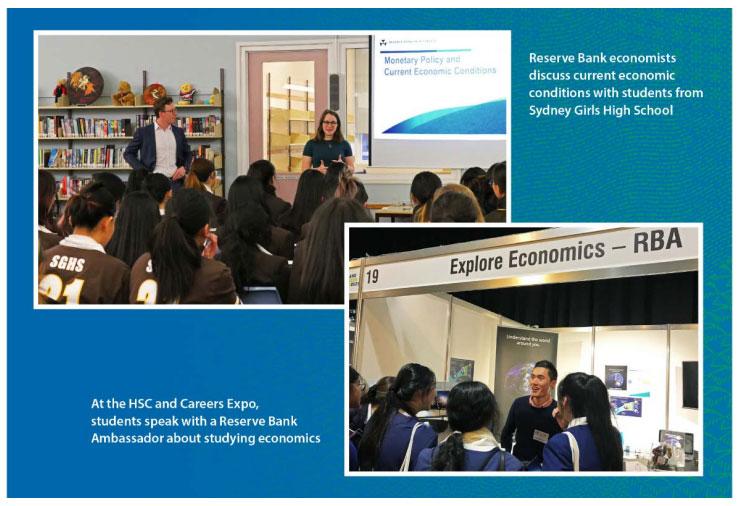
The combination of webinars and some in-person talks and careers events enabled the Bank's public education program to directly reach over 7,000 students in 2021. This reach was up significantly from the previous year, and with an increase by geographic location and school type. In particular, webinars enabled presentations to schools that had previously not engaged with the Bank, and allowed more focused engagement with university students.
Additional educational resources were developed for Years 7–10 students to introduce them to economics in their junior to middle years of high school. These resources are aligned with the core economics component of the new NSW Commerce Syllabus, but are also relevant to other subjects (across all states) that include aspects of economics. In addition, resources were produced on reading and interpreting charts about economic variables, relevant to a wide cross-section of students at school and university.
Further research was undertaken to guide the strategic direction of the public education program. Using a new administrative dataset on university admissions, research was conducted on the transition from school to university economics, with the results published in the June 2021 issue of the Bulletin.[3] This research identified pathways and obstacles for different student groups that can inform approaches to encouraging them to choose economics at university. It complemented earlier work in which the Reserve Bank collaborated with Ipsos to undertake a detailed survey of high school students, which investigated why they choose particular subjects and their perceptions of economics. This work culminated in a Research Discussion Paper, which was also published in June 2021.[4] In addition, a survey was conducted of economics teachers, identifying their confidence and experience in teaching economics, their perceptions of the effectiveness of the Bank's resources and their requirements for additional support.
The Educators Advisory Panel – which comprises external education experts who advise on the strategic direction of the Bank's public education program – met twice virtually during the year to review the program's progress.
Museum
The Reserve Bank's Museum showcases a permanent collection of artefacts and hosts additional periodic exhibitions. In the permanent collection, visitors can view the various types of money used in Australia before Federation through to the innovative new series of ‘next generation’ banknotes. Visitors can trace the evolution of the nation's identity as expressed through its banknotes and learn about the influential women and men depicted on them. They can also see the artwork used in banknote design, learn about how banknotes are made and discover their security features.
The Museum released the final installment of the next generation banknotes display called A New Vision for Banknotes. Information about the new $100 banknote was added to that for the $20 banknote (released in 2019), the $50 banknote (released in 2018), the $10 banknote (released in 2017) and the $5 banknote, which launched the new series in 2016. The display has been designed to capture the innovative properties of the new banknotes; it provides details about their design and production, and their tactile accessibility feature for people who are vision-impaired. A large multi-touch screen enables visitors to explore the design elements and security features of the new banknotes, along with the rich historical and social context of the imagery and stories that the banknotes contain - for the new $100 banknote, this relates to the lives of General Sir John Monash and Dame Nellie Melba.
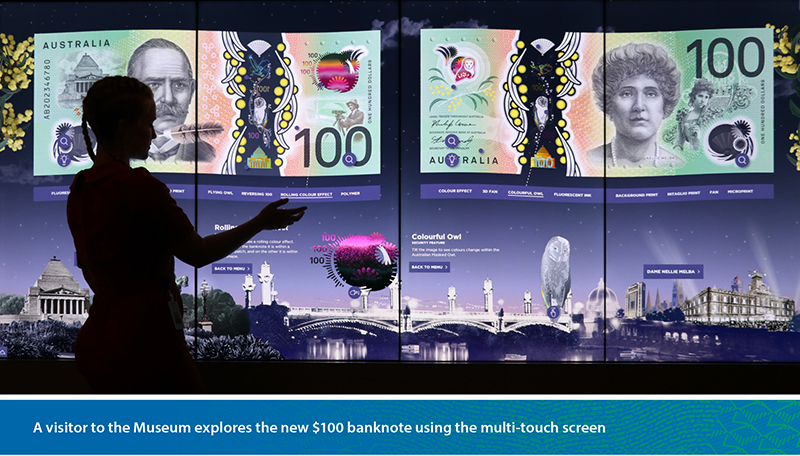
At the onset of the pandemic, visits to the Museum were suspended, including for the talks and events typically hosted there. The Museum reopened to limited visitors in March 2021 when bookings resumed for students and some other groups. Given constraints on the use of the physical space associated with COVID-19, the focus shifted to the Museum website, which was redesigned to accommodate new online displays. Prominent among these displays was Exploring Australian Banknotes with its five Pocket Guides.[5] These Guides form a comprehensive catalogue of the banknotes that have been issued in Australia, including the social and historical context of their design. Additionally, the Pocket Guides were published as physical booklets to complement the presentation of the actual banknotes in the Museum.
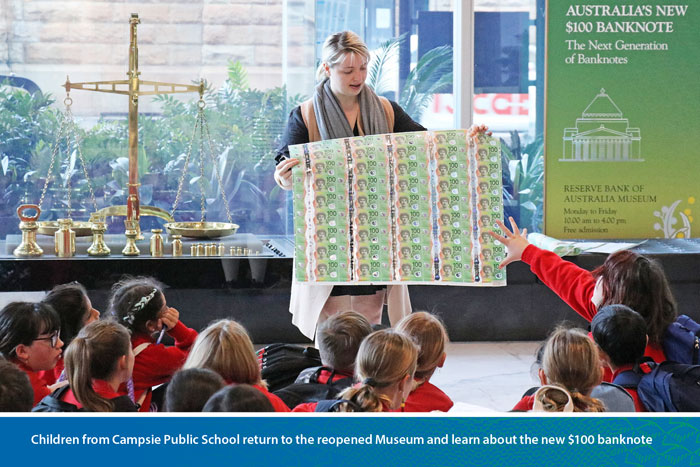
Smaller online exhibitions were also produced during the year. These included King O'Malley, which examined the colourful and at times controversial politician in the period following Federation.[6] King O'Malley was a significant figure in the initiative to create a national bank with central banking responsibilities. This online exhibition was accompanied by a physical display in the Museum of artefacts from the Reserve Bank's archives about O'Malley, including his famous pocket watch, which was used as the official timepiece at the ceremony naming Canberra as the capital of Australia.
The Museum collaborated with the Art Gallery of New South Wales (AGNSW), lending the maquette of the Bank's sculpture by Margel Hinder to the gallery for a major retrospective of her work. The Bank's curators gave talks about this public sculpture to members of the AGNSW and Museum visitors.

Archives
The Reserve Bank has a unique and rich archives collection. In addition to records about the Bank's own operations, the archives contain records about Australia's economic, financial and social history over nearly 200 years. The records predate the central bank as it is known today because the Reserve Bank had its origins in the Commonwealth Bank of Australia, which had a central banking function and had absorbed other banks with a colonial history.
During 2020/21, the Reserve Bank launched a digital archive, Unreserved. Unreserved enables users independently to research and download digital versions of key archival records, learn about the nature and scope of the Bank's archival collection, and lodge requests for information or assistance from the archivists.
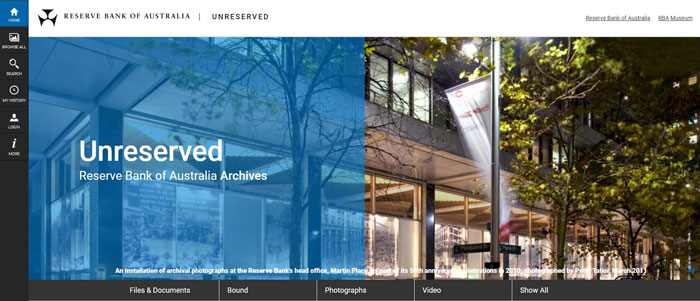
The first tranche of digitised records released through Unreserved included:
- colonial banking records – a set of records relating to six colonial banks operating in Australia during the 19th century; these records are from 1824 to 1935 and include convict banking records
- the London Letters – a series of information sent between the Bank's Head Office and its London Office from 1912 to 1975
- the New York Agency records – a series of correspondence, banking records and financial vouchers for the Bank's original New York Agency over its short period of existence from 1927 to 1929
- the Papua New Guinea series – a series covering the creation of a financial system and central bank in Papua New Guinea, financial education, economic and financial surveys, and preparations for the transfer of activities to the Bank of Papua New Guinea ahead of the nation's political independence in 1975
- audio visual collections – various series of film, photographs and glass plate negatives covering the Bank's buildings and staff during the First World War, the early built environment of Sydney and other locations in which there are Bank buildings, and the Bank's activities in Papua New Guinea.
Together, these digitised series provided a ‘sampler’ of the content of the Reserve Bank's archives. They were accompanied by index lists of the Bank's entire archival collection and key metadata for those series that are yet to be digitised. A second tranche of records is expected to be released in September 2021, with twice yearly releases thereafter.
To showcase the value of the archival records, a Bulletin article explored the content of the London Letters and summarised the insights they provide to the central bank's experience of some of the most significant events of the 20th century.[7] It was accompanied by another Bulletin article, which used the historic banking ledgers to analyse household depositor behaviour in Australian depressions.[8]
In addition to the development and launch of Unreserved, the Archives team continued to respond to requests for information that was outside the scope of records contained in Unreserved. They dealt with around 120 research requests from both Australia and overseas on a very diverse range of topics, including family history and banknotes. There was also a number relating to the Second World War, brought about by the 75th anniversary of the Armistice in 2020.
While the COVID-19 outbreak required the closure of the Reserve Bank's Archives repository and public research room throughout 2020/21, the archivists were able to support most requests for information remotely by accessing digital versions of records that were then shared with researchers using the Bank's secure external collaboration tool, RBA Box. These researchers included the Bank's Historian, Associate Professor Selwyn Cornish of the Australian National University, who continued to make considerable progress documenting the 1975–2000 period of the Reserve Bank's official history.
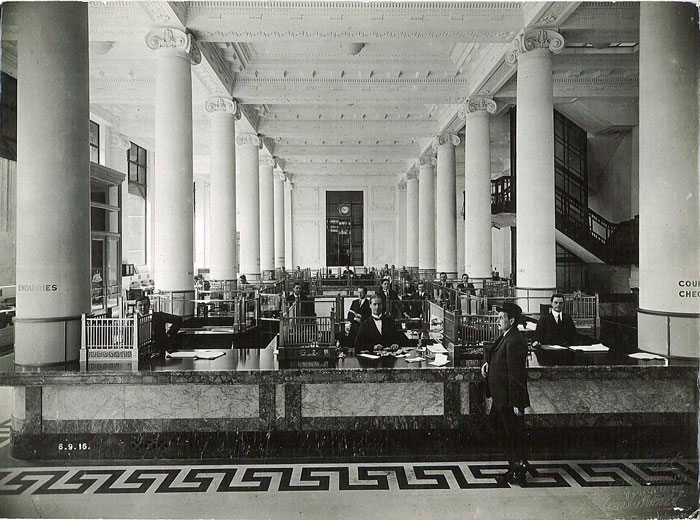
Charitable activities
During 2020/21, the Reserve Bank made its 19th annual contribution of $50,000 to the Financial Markets Foundation for Children, which is chaired by the Governor. Coinciding with the release of the final denomination of the new generation banknote series, the Bank donated an uncut sheet of banknotes to the ASX Refinitiv Charity Foundation. As the final such sheet to be donated, it raised $71,000 at auction. The Foundation includes the Financial Markets Foundation for Children in the distribution of auction proceeds. In September 2021, the Governor is scheduled to deliver his fifth address to the Anika Foundation's annual event to raise funds to support research into adolescent depression and suicide. This will be the 16th such event supported by the Bank.
The Reserve Bank supports several staff-led charitable initiatives, key among which involves dollar-matching staff payroll deductions (totalling $117,100 in 2020/21) organised by the Reserve Bank Benevolent Fund. The Fund supports a set of 15 recognised charities working in the areas of welfare, education, mental health, illness, disability, international medical aid and animal protection. The Bank also facilitates staff salary sacrificing under a Workplace Giving Program.
The Bank matched staff donations for the Benevolent Fund's Christmas appeal for Foodbank Australia and Barnardos Australia. Staff participated in the Cancer Council's Biggest Morning Tea event, where fundraising was matched by the Bank. In October 2020, the Bank donated toys to The Smith Family totalling $5,600 in lieu of the staff's Children's Christmas Party.
Following the devastating impact of the COVID-19 pandemic, Bank staff raised $11,529 for the India COVID-19 Relief Appeal in a fundraising initiative organised by the Benevolent Fund. These fundraising efforts were supported by the Bank's Race and Cultural Identity Employee Resource Group, which held a coin drive during Eid celebrations in May to support the appeal.
Reserve Bank staff participated in one volunteering activity in 2020/21 with Barnardos Australia.
The Reserve Bank's contributions under all these initiatives in 2020/21 totalled $187,834.
Endnotes
See Lewis M and Q Liu (2020), ‘The COVID-19 Outbreak and Access to Small Business Finance’, RBA Bulletin, September. [1]
See Black S, K Lane and L Nunn (2021), ‘Small Business Finance and COVID-19 Outbreaks’, RBA Bulletin, September. [2]
Lovicu G (2021), ‘The Transition from High School to University Economics’, RBA Bulletin, June. [3]
Livermore T and M Major (2021), ‘What Is Driving Participation and Diversity Trends in Economics? A Survey of High School Students’, RBA Research Discussion Paper No 2021-06. [4]
See RBA Museum, ‘Pocket Guides to Australian Banknotes’. Available at <https://museum.rba.gov.au/exhibitions/pocket-guides>. [5]
See RBA Museum, ‘King O'Malley’. Available at <https://museum.rba.gov.au/exhibitions/collection-spotlight/king-o-malley.html>. [6]
See Dwyer J and V MacDonald (2021), ‘From the Archives: The London Letters’, RBA Bulletin, March. [7]
See La Cava G (2021), ‘The Anatomy of a Banking Crisis: Household Depositors in the Australian Depressions’, RBA Bulletin, March. [8]